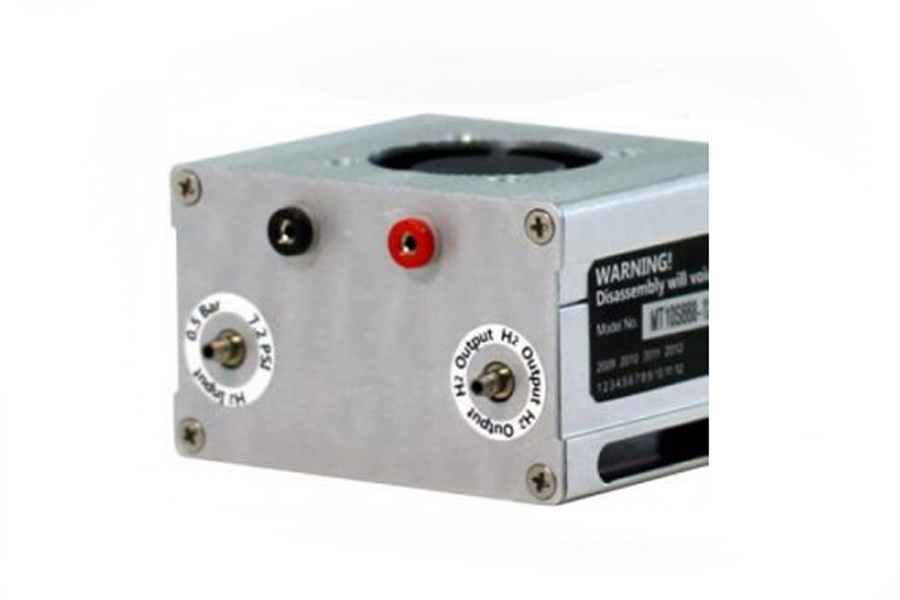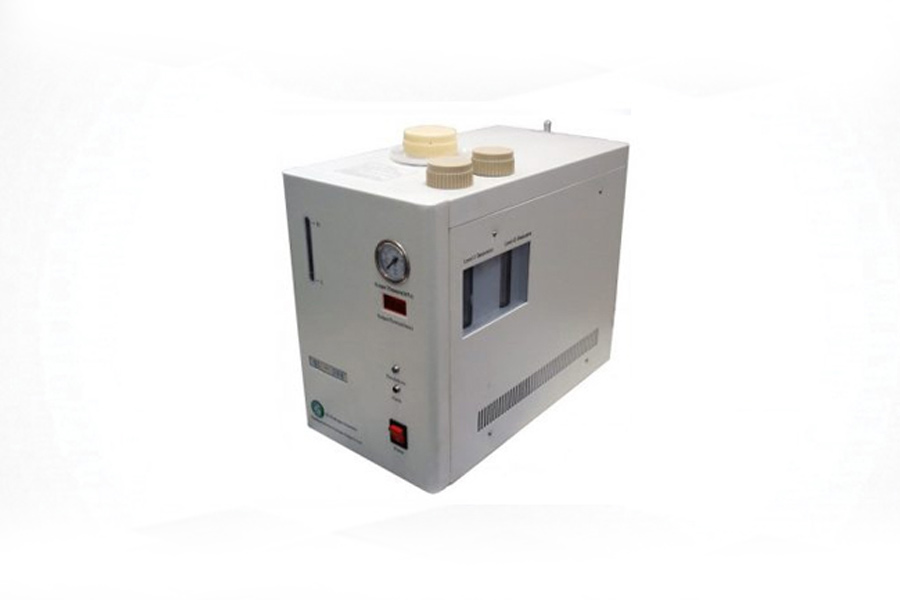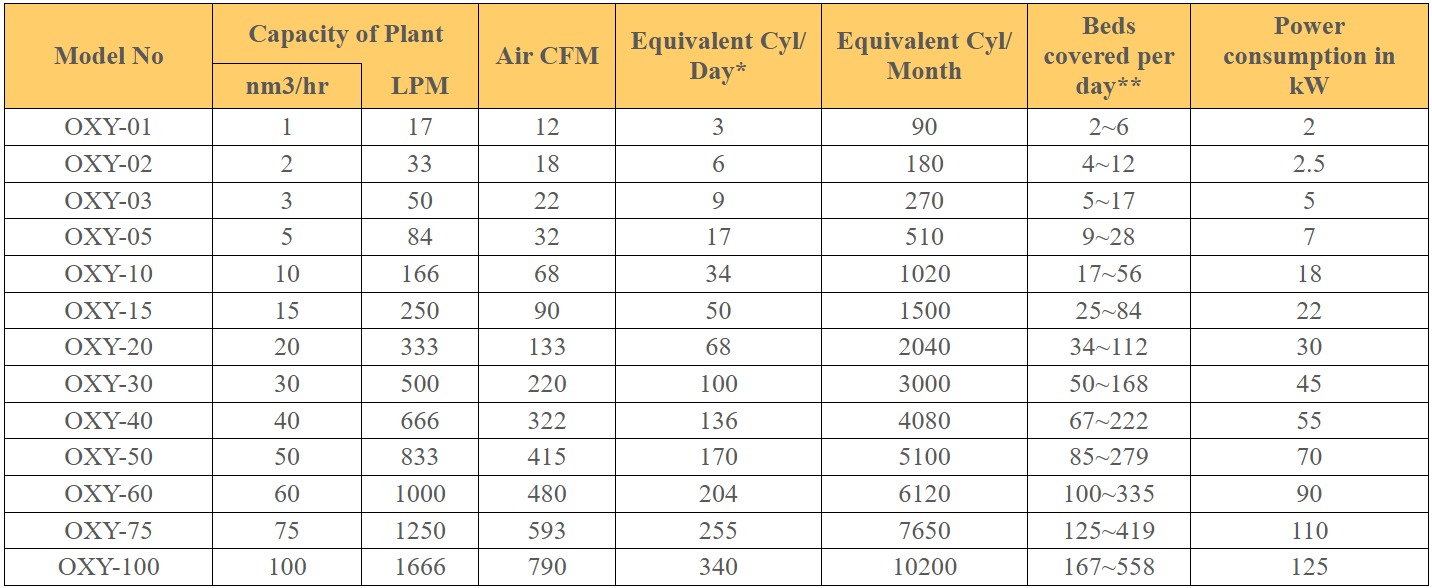Fuel Cell Store
7-Cell Dismantlable PEM Fuel Cell Stack:

Key Features:
- 7 Cell Stack
- Power Output: 50 watts
- Active Area: 50cm²
- Aluminum End Plates
- Gold plated current collectors
- Machined graphite separator plates
- Banana plugs for monitoring voltage
- Belleville washer
- Air-cooled – water-cooled stack
- Stainless Steel fittings for gas tight connection to 1/4 inch tubing
- Silicone Gasketing
- Weight: 8.8 pounds, 4kg
PEM Interdigitated Fuel Cell Stack

The PEM Interdigitated Fuel Cell is a high performance fuel cell stack with a new separator plate design giving a highly efficient reactant transport, and with a careful connector design providing corrosion resistance. The stack is built with robust quality and durability allowing for repeated assembly and dis-assembly.
The new separator plate includes an interdigitated flow field design, so that reactant is forced through the porous gas diffusion layer (GDL). The forced flow helps to transport reactant to the reactive catalyst layer thus reducing mass transfer limitation and increase power output. The fuel connection is specifically designed and made with a direct connection between the graphite separator plate and Nylon (or Teflon) fittings, so that fuel and the current collector and end plate do not come in contact, making them corrosive resistant.
The stack with the interdigitated plate is available in 50 cm². A cooling plate is also available for the 50 cm² stack.
Horizon 12W PEM Fuel Cell

Horizon’s new H-12 PEM Fuel Cell System is the lightest, most compact (and most competitively priced) 12W system in the world. The H-12 Fuel Cell is a 12 Watt air fed / air cooled, hydrogen fuel cell suitable for many small projects and uses. Because this fuel cell is air cooled there is no need for large, complicated, and expensive water cooling systems. This semi-integrated unit is provided in kit format complete with air blower, control electronics and hydrogen supply valve.
Includes:
- Integrated fan and casing
- 12W stack with blower
QL-150 PEM Hydrogen Generator

QL Hydrogen Generator is used to generate up to 99.9995% purity hydrogen by world advanced PEM technology. The product hydrogen can be used for for gas chromatography (GC) carrier gas and fuel gas, ICP-MS collision gas, hydrogenation reactor, fuel cell, and emissions test equipment. It is the ideal equipment to replace regular gas cylinders in the laboratory. The QL Hydrogen Generator is the solution of choice for on-site gas production.
Electrolyzer Hardware – Square

Electrolyzer research and development provides the crucial link to make the renewable energy concept and hydrogen energy a reality. The unpredictability of having the supply of power when needed will no more be an issue. Excess unused power generated from solar and wind can be used to generate, and store hydrogen for a later use for filling a car, and/or to use in a fuel cell for distributed, emergency power and other hydrogen energy solutions.
The Electrolyzer Research Hardware provides a reliable hardware with many built-in flexibilities for studying different materials for flow-field, different catalysts, membranes, and current distributors.
QL-2000 PEM Hydrogen Generator

QL Hydrogen Generator is used to generate up to 99.9995% purity hydrogen by world advanced PEM technology. The product hydrogen can be used for for gas chromatography (GC) carrier gas and fuel gas, ICP-MS collision gas, hydrogenation reactor, fuel cell, and emissions test equipment. It is the ideal equipment to replace regular gas cylinders in the laboratory. The QL Hydrogen Generator is the solution of choice for on-site gas production.
Laboratory Hydrogen Generator – G600

The Hydrogen G600 bench-top stackable generator utilizes Proton Exchange Membrane (PEM) cell stack and desiccant dryer to produce UHP hydrogen for laboratory applications at 600 cc/min. The G600 Hydrogen Generator system is capable of sensing demand and adjusting production rate, while maintaining quiet operation. This ultra-high purity, low mainteneance hydrogen generator is frequently used to supply hydrogen for GC and GC/MS or all commonly used combustion detectors used routinely with GCs. This Hydrogen Generator generates hydrogen on-demand at low pressures (up to 116 psi) as a safe and economical replacement for compressed gas storage.
Safe Operation: The purge airflow monitoring system and an automatic leak detection system assure the environment below LFL.
Efficiency: Water monitoring system (with purity monitor), system senses, auto-fill water level control and automatic production control guarantee the system running at optimal level.
Convenience: It is equipped with removable water feed tank, maintenance diary, report alarms and a touch screen display.
Hy PEM XP 480 Rack

The H2 mini-stations have arrived for domestic, corporate, laboratory and industrial applications. The Hy PEM XP 480 Rack is used to produce hydrogen in every place by capturing the energy of renewable sources! This electrolyzer requires no maintenance and provides maximum reliability.
The hydrogen release pressure is adjustable up to 16 bar according to the ideal parameters to recharge a hydride cartridges with metal hydrides of any type. Ultra-pure hydrogen gas maximizes efficiency and life of metal hydride cartridges.
Fumasep FBM – Bipolar Membrane

Fumasep FBM Bipolar Exchange Membrane with PK reinforcement consists of an anion exchange layer and a cation exchange layer manufactured using a patented multilayer-coating production technology.
This composite membrane is chemically stable and mechanically reinforced with woven PEEK. In the intermediate layer between Anion Exchange Layer (AEM) and Cation Exchange Layer (CEM) water is catalytically active to force dissociation of water into OH- and H+ – ions when exceeding a potential difference of approximately 0.8 V. The membrane should be operated under forward bias conditions which may cause blistering. The CEM must be directed towards the cathode, the AEM must be directed towards the anode. If the membrane is used in the wrong position at high current density even for short term, the interim layer may degrade (blistering), and the monolayers may delaminate.
AEM Water Electrolyzer – 5cm²

The AEM Water Electrolyzer is a complete alkaline anion exchange membrane water electrolyzer hardware. The hardware includes corrosion resistant 5 cm² Nickel anode and cathode flow fields, an MEA with base metal catalysts, metal gas diffusion layers, o-ring seals, and Teflon gasketing. Please note that there are no heaters or cables included.
The electrolyzer is designed to be run with 1 M KOH flowing on the anode and cathode as described in Zengcai Liu et al. “The effect of membrane on an alkaline water electrolyzer”.
CO2 Electrolyzer – 5cm²

The AEM Water Electrolyzer is a complete alkaline anion exchange membrane water electrolyzer hardware. The hardware includes corrosion resistant 5 cm² Nickel anode and cathode flow fields, an MEA with base metal catalysts, metal gas diffusion layers, o-ring seals, and Teflon gasketing. Please note that there are no heaters or cables included.
The electrolyzer is designed to be run with 1 M KOH flowing on the anode and cathode as described in Zengcai Liu et al. “The effect of membrane on an alkaline water electrolyzer”.
Sustainion® X37-50 Grade RT

Sustainion® X37-50 Grade RT is an anion exchange membrane with a dry thickness of 50 microns and is designed for use with a supporting electrolyte. It has been optimized for use in alkaline water electrolyzers and CO2 electrolyzers. The membrane will be shipped with an ethylene glycol plasticizer to prevent cracking. The plasticizer is designed to wash out during activation.
Expandable PEM Research Test Cell – 50cm²

Building on the strong history of PEM fuel cell research and test data using 50cm² cells, the Expandable PEM Research Cell is a robust development tool using well established materials, techniques and quick assembly features. These features make it ideally suited for sample screening, research and development, and educational purposes. As a short stack, it is ideal for advanced system testing.
PEM Fuel Cell Hardware

Fuel Cell Hardware is an electrochemical device that converts chemical fuel, such as hydrogen, natural gas, methanol, etc. into energy and water. This item includes all the key components to make such reactions occur. It also performs compression of the membrane electrode assembly (MEA) while providing uniform gas distribution and uniform temperature to the cell.
A gold-plated plate serves as current collector plate for the fuel cell. The gold plating provides corrosion protection and good electrical contact with the graphite separator plate. A high purity graphite plate with high electrical conductivity (900 Scm-1) and high thermal conductivity (117 Wm-1K-1) is designed with gas flow channels and manifold. A Gasket is included to provide a secured seal for the MEA. High power silicon rubber heaters are installed at both ends of the fuel cell to maintain a constant cell temperature.
Interchangeable Test Hardware – 25cm²

Fuel Cell Store’s Single Cell Interchangeable Test Hardware was designed by one of the leading companies in electrochemical research and development to be one of the highest quality and most flexible test fixtures on the market. The test fixture is custom machined from stainless steel to provide flat, even compression across the entire face of your test MEA. The plates are gold plated for maximum conductivity to alleviate parasitic contact losses during your testing. The endplates are pre-drilled for 3/16” cartridge heaters (2 per endplate), or they also have a single pass port, on each endplate, for water to circulate to control the temperature via an external temperature bath. To read the temperature of the cell, each endplate has a 1/8” smooth thermocouple port and an 8-32 tapped port for a surface mount temperature sensor.
Nafion™ 212

Nafion™ Membrane is used to separate the anode and cathode compartment of Proton Exchange Membrane fuel cells and water electrolyzers. The thickness of this particular cation exchange membrane, Nafion™ 212 makes it suitable for many Hydrogen Air/Oxygen Fuel Cell applications. Nafion™ 212 is 50.8 micrometers (2 mil) thick. The membrane is positioned between a backing film and a coversheet.
Chemours (formerly DuPont) Nafion™ PFSA NR-212 membranes are based on chemically stabilized perfluorosulfonic acid/PTFE copolymer in the acid (H+) form, and exhibit substantially lower fluoride ion release compared to the non-stabilized polymer – a sign of improved chemical durability. Nafion™ PFSA membranes are widely used for Proton Exchange Membrane (PEM) fuel cells and water electrolyzers. The membrane performs as a separator and solid electrolyte in a variety of electrochemical cells that require the membrane to selectively transport cations across the cell junction. The polymer is chemically resistant and durable.
Fumasep FAS-PET-75

Fumasep FAS-PET-75 is a PET reinforced Anion Exchange Membrane (AEM) with low resistance, high selectivity, high mechanical stability, and high stability in pH neutral and acidic environments.
Fumasep FAS-PET-75 membrane comes in either a 10cm x 10cm or 20cm x 30cm size sheet that is delivered in a dry brown-foil form.
Fumatech membranes are highly sensitive to differences in humidity and moisture content. Therefore the membranes can vary +/- 0.5cm from the original cut sizes. Also due to this sensitivity the manufacturer expects wrinkles to form, however soaking the membranes in deionized water will return the membranes to the full size planar state according to the manufacturer.
CeTech GDS090

CeTech GDS090 is a carbon paper without a Microporous Layer (MPL). It has a total thickness of 90 um (microns). CeTech is a great low-cost alternative to conventional carbon paper Gas Diffusion Layer (GDL) materials.
eTech GDS090 is available in 20 x 20 cm or 40 x 40 cm sheets at this time.
Advantages of CeTech Carbon Paper:
- Heat transfer during cell operation
- Automated QC inspection system
- Keep some water on the surface for conductivity
- Avoid “flooding”
Horizon 300W PEM Fuel Cell

CeTech GDS090 is a carbon paper without a Microporous Layer (MPL). It has a total thickness of 90 um (microns). CeTech is a great low-cost alternative to conventional carbon paper Gas Diffusion Layer (GDL) materials.
eTech GDS090 is available in 20 x 20 cm or 40 x 40 cm sheets at this time.
Advantages of CeTech Carbon Paper:
- Heat transfer during cell operation
- Automated QC inspection system
- Keep some water on the surface for conductivity
- Avoid “flooding”
- Salient Features
- Standard Modules
- Fully Automated System, touch screen with data logging
- Oxygen generation plants are skid mounted modular designs, pre-piped and assembled, easy for transportation, compact in design and plug and play onsite.
- Ready to use easy to go…!
- Safety interlocks: over pressure, over temperature, oxygen purity etc. interlocks make sure that plant is working in safe conditions.
- High Reliability: Very reliable for continuous and steady operation with constant Oxygen purity.
- Our plants meets Worldwide Medical Oxygen Grade Standards
- Cost Saving of up-to 80% from Liquid/Cylinder supply
- Dependable Highest Reliability with Energy Efficiency
- Easily Partial Load Operation in variable Demand Flows
- Ready to use upon delivery
- Easy to maintain with Continuously monitored Purity & Flow
- Optional Cylinder filling Ramp with Emergency Disaster Recovery

*Considering standard 7m3 cylinder
** Figures not standard, considering min 3 L/min to max 10L/min average consumption of oxygen by one patient in 24 hours, flow rates may vary depending upon patient’s consumption and uses by plant owners.
*** Custom designs can be made upon request and demand
Primary Responsibilities :
- 1.Making Drawing for Pressure Vessel, column, Heat Exchanger etc.
- 2.Making Dosing System Drawing as per client P &ID.
- 3.Having Experience in EPC Project
- 4.Designing of Manufacturing components, Assembly, GA drawing and assembly of project
- 1.Work with multiple discipline projects
- 2.Managing and monitoring all assigned Projects
- 3.Site Engineering, Project Management
- 4.Documents Management
- 5.Subordinate and Senior Relations
- 6.Work within Time and Accuracy (No any complaints)
- 7.Discipline on Office (Proper Dress up, Appearance, Duty Timings, Communication)
Primary Responsibilities :
- Preparation of Project Planning & Scheduling, Attending project Kick off meetings.
- One point contact to customer.
- Act as main coordination between Customer, Factory, and Supplier.
- Monitor the overall progress of projects against schedule and reporting to management.
- Maintain detailed project files and applicable records.
- coordinate the assigned project work during all project phases
- Manage budget, procurement and schedules for various projects.
- Provide approved documents along with manufacturing schedule based on the Commercial situation, inventory & time frame to the factory & supplier.
- Follow-up with supplier & factory for manufacturing status.
- Provide the project progress status to customer & management.
- Coordination of the inspection activity with factory, supplier, customer & TPI as per customer requirements
- Work with multiple discipline projects
- Managing and monitoring all assigned Projects
- Site Engineering, Project Management
- Documents Management
- Subordinate and Senior Relations
- Work within Time and Accuracy (No any complaints)
- Discipline on Office (Proper Dress-up, Appearance, Duty Timings, Communication)
- Having experience in EPC projects.
- Having knowledge of exposure to pressure vessels, various types of process equipment, skid mounted systems is must.
- Hould be able to prepare GA Drawings, Detailed fabrication drawings to support manufacturing .
- Assembly of Shell & Tube Heat Exchangers, reactors, pressure vessels, skid, piping/ tubing etc
- Should have experience of Preparation of Pipeline drawing – PFD / PID
- Preparation of GAD/ layouts for projects.
- Having experience in EPC projects.
- Having knowledge of exposure to pressure vessels, various types of process equipment, skid mounted systems is must.
- hould be able to prepare GA Drawings, Detailed fabrication drawings to support manufacturing .
- Assembly of Shell & Tube Heat Exchangers, reactors, pressure vessels, skid, piping/ tubing etc
- Should have experience of Preparation of Pipeline drawing – PFD / PID
- Preparation of GAD/ layouts for projects.
- Conducting product research and sourcing new suppliers and vendors.
- Sourcing materials, goods, products, and services and negotiating the best or most cost-effective contracts and deals.
- Performing inventory inspections and reordering supplies and stock as necessary.
- Conducting market research to keep abreast of emerging trends and business opportunities.
- Updating and maintaining records of all orders, payments, and received stock.
- Excellent networking and time management skills.
